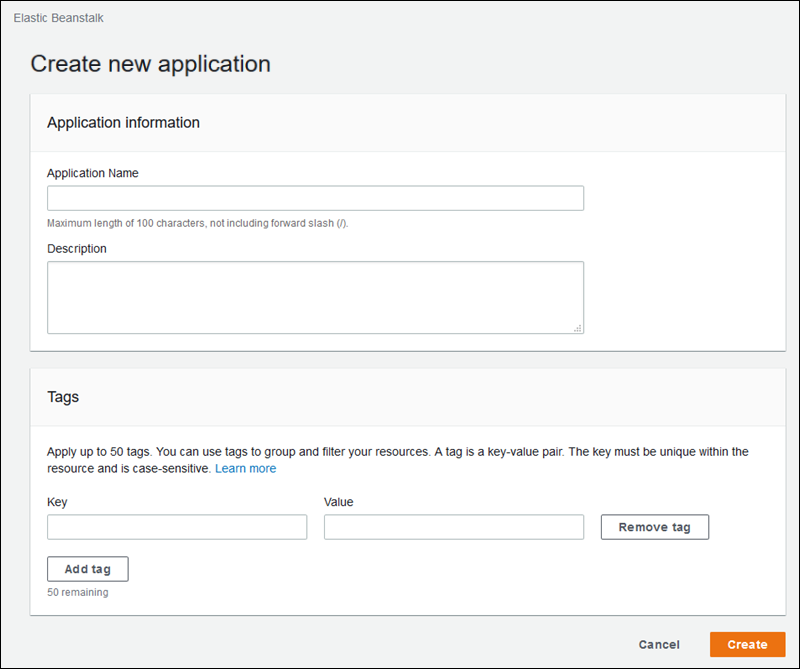Tagging applications
You can apply tags to your Amazon Elastic Beanstalk applications. Tags are key-value pairs associated with Amazon resources. For information about Elastic Beanstalk resource tagging, use cases, tag key and value constraints, and supported resource types, see Tagging Elastic Beanstalk application resources.
You can specify tags when you create an application. In an existing application, you can add or remove tags, and update the values of existing tags. You can add up to 50 tags to each application.
Adding tags during application creation
When you use the Elastic Beanstalk console to create an application, you can specify tag keys and values in the Create New Application dialog box.

If you use the EB CLI to create an application, use the --tags option with eb init to add
tags.
~/workspace/my-app$ eb init --tags mytag1=value1,mytag2=value2With the Amazon CLI or other API-based clients, add tags by using the --tags parameter on the create-application command.
$ aws elasticbeanstalk create-application \
--tags Key=mytag1,Value=value1 Key=mytag2,Value=value2 \
--application-name my-app --version-label v1Managing tags of an existing application
You can add, update, and delete tags in an existing Elastic Beanstalk application.
To manage an application's tags in the Elastic Beanstalk console
Open the Elastic Beanstalk console
, and in the Regions list, select your Amazon Web Services Region. -
In the navigation pane, choose Applications, and then choose your application's name from the list.
Note
If you have many applications, use the search bar to filter the application list.
-
Choose Actions, and then choose Manage tags.
-
Use the on-screen form to add, update, or delete tags.
-
To save the changes choose Apply at the bottom of the page.
If you use the EB CLI to update your application, use eb tags to add, update, delete, or list tags.
For example, the following command lists the tags in an application.
~/workspace/my-app$ eb tags --list --resource "arn:aws-cn:elasticbeanstalk:us-west-2:my-account-id:application/my-app"The following command updates the tag mytag1 and deletes the tag mytag2.
~/workspace/my-app$ eb tags --update mytag1=newvalue --delete mytag2 \
--resource "arn:aws-cn:elasticbeanstalk:us-west-2:my-account-id:application/my-app"For a complete list of options and more examples, see eb tags.
With the Amazon CLI or other API-based clients, use the list-tags-for-resource command to list the tags of an application.
$ aws elasticbeanstalk list-tags-for-resource --resource-arn "arn:aws-cn:elasticbeanstalk:us-west-2:my-account-id:application/my-app"Use the update-tags-for-resource command to add, update, or delete tags in an application.
$ aws elasticbeanstalk update-tags-for-resource \
--tags-to-add Key=mytag1,Value=newvalue --tags-to-remove mytag2 \
--resource-arn "arn:aws-cn:elasticbeanstalk:us-west-2:my-account-id:application/my-app"Specify both tags to add and tags to update in the --tags-to-add parameter of update-tags-for-resource. A nonexisting tag is
added, and an existing tag's value is updated.
Note
To use some of the EB CLI and Amazon CLI commands with an Elastic Beanstalk application, you need the application's ARN. You can retrieve the ARN by using the following command.
$ aws elasticbeanstalk describe-applications --application-names my-app